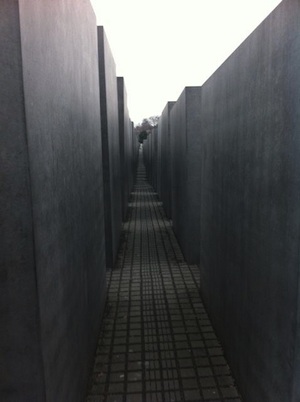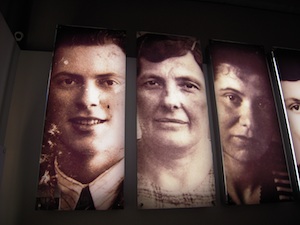

I took two steps into the square where the gray stone slabs were purposefully placed on the ground, and was immediately confused. I wasn't sure what was going on, which way to turn or which path I should take. The walls seemed normal at first -- almost as if I could carry on a conversation with friends as I walked through toward an unknown destination. Seconds later I was lost in a maze of gray. The slabs had grown bigger, I felt smaller and could hear my own breathing. There was little light and I felt trapped; I was afraid to speak, and unsure what I even would say. I maneuvered my way through the maze of gray, wondering when the end will come. Suddenly, and without warning, I emerged among the smaller slabs of gray and into daylight. Suddenly, I was free from the maze. I had survived. This was Berlin's way of reminding all who walk through this memorial that 6 million Jews never found their way out, and were never free again.
I arrived Berlin eager to see all I could in three days, but I had a secret mission to research my family's past. Germany's history is tumultuous, to say the least, and it's not uncommon for tourists to want to explore the country's dark past -- this visit was no different for me. I never had the opportunity to walk the streets my German ancestors walked before they were forced to wear yellow bands marking them "Jews" and shipped off to concentration camps. Today would be a day that I'd never forget.
I took two steps into Berlin's Holocaust Memorial and had to catch my breath. The memorial itself was built to be interpreted differently by each individual who walks through. U.S. architect Peter Eisenman's controversial design of The Memorial to the Murdered Jews of Europe was approved in 1999 and in 2005, the memorial opened as a tribute to the Jews who died before and during World War II under Hitler's reign. The memorial occupies about 205,000 square feet of space near the Brandenburg Gate, and just a short distance from where the ruins of Hitler's bunker is buried. The space is comprised of 2,711 gray stone slabs that sit in a wave-like pattern. There are no markings, such as names or dates or numbers, on the slabs. Each is five-sided and unique in shape and size -- no two slabs are alike, but each bear a significant meaning. It's said that Eisenman wanted to create a feeling of instability and a sense of disorientation when he architected this memorial -- most who walk through will agree he succeeded.

Underground the memorial is a documentation room that holds the names of all known Jewish Holocaust victims. It depicts the events of the Holocaust, profiles the lives lost and portrays photos and postcards that were found following the war. There are letters laid in glass on the floor in a dark room guided by a small light under each letter -- the originals on the left, its English interpretation on the right. I walked through reading each and every story, and gazing at the family portraits on the wall. The last letter I read was from a mother to her daughter. They were told they were being shipped off to work and earn money for the family; the mother was taken first, and was the first in the family to witness unfortunate reality of what was happening. She penned a note to her daughter, telling her what was ahead, asking her to hug her father, and reminding her to be strong. She ended the letter with, "I'll always love you, Mama."
By this time, my heart was heavy looking around at the families on the walls. I thought about my family and what it would be like for my mother to write that letter to me. I thought about how far we've come as Jews and how even in a current state of unrest around the world, we have a freedom that was unknown to our ancestors. I thought about my family members who were lost in the Holocaust, and what dreams they might have had for themselves and their children. I wondered what they might have dreamed up for me. At that moment, I walked away from the book of names. I decided against flipping through documents looking for the names that never filled my family tree. I didn't want to know of their suffering, which camps they were sent to, how old they were or how many children they had. I already know how the story ends. Instead I focused on now -- how in some small way, I am the voice for my family members who didn't have one simply because of their religion. I am one of the hopeful products created from an unfortunate past.
I found myself in a reflective mood the rest of the day. That evening, as I was sitting at The Curtain Club, the Ritz-Carlton Berlin's hotel's bar, I paid closer attention to the people around me. All the seats in the bar were filled with various ages, religions, and cultures. I looked around the room and I wondered about their past. I wondered if they knew they were sitting in a bar that once would have divided East and West Berlin, or what side of the wall they lived on. I wondered if they knew that the person who handled their luggage this morning or poured their drink this evening was at one point in time a prisoner in their own country. I wondered how many of them had Jewish ancestors who perished in the Holocaust, or whose family members might have served in the Third Reich. I wondered if they had a family tree that was full or if theirs, too, had blank leaves for family members they had no information on.
On this day in Berlin I walked through history, retracing the roots of my family tree and immersing myself in the dark past of my Jewish heritage. I stood in front of the remnants of the Berlin Wall -- just steps from the Holocaust Memorial -- and thought about the Berliners who prayed for their freedom not too long ago. I wondered what it must have been like to wonder if tomorrow would be better than today.
Special thanks to the Ladies and Gentleman at The Ritz-Carlton Berlin who took time to walk through the past with me.